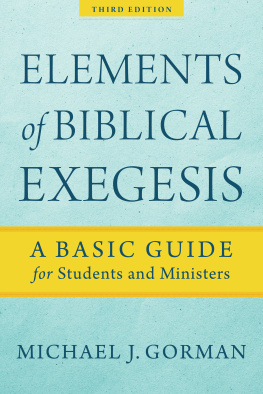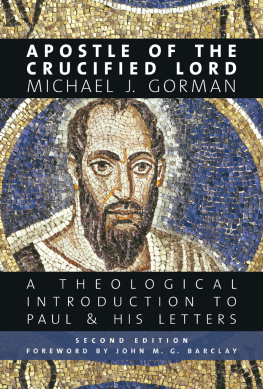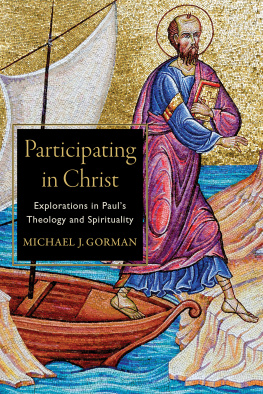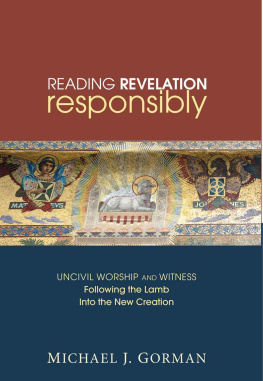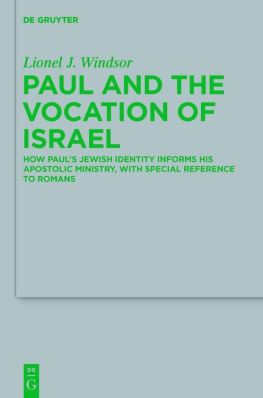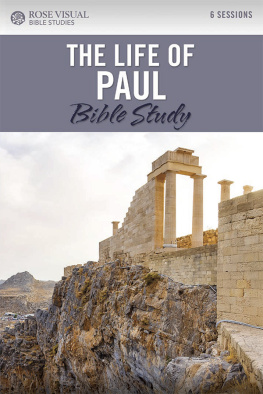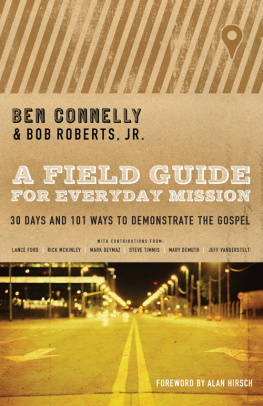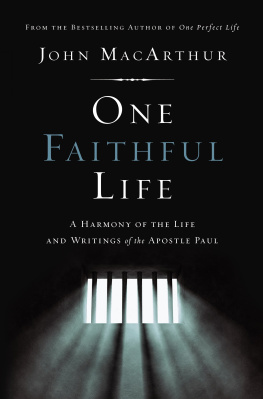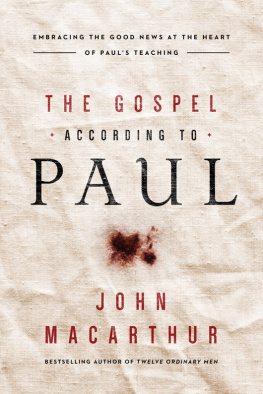The Gospel and Our Culture Series
A series to foster the missional encounter of the gospel
with North American culture
John R. Franke
General Editor
Volumes Published to Date
Lois Y. Barrett et al., Treasure in Clay Jars: Patterns in Missional Faithfulness
James V. Brownson, Inagrace T. Dietterich, Barry A. Harvey,
and Charles C. West, StormFront: The Good News of God
Michael J. Gorman, Becoming the Gospel: Paul, Participation, and Mission
Darrell L. Guder, The Continuing Conversion of the Church
Darrell L. Guder et al., Missional Church: A Vision for the
Sending of the Church in North America
George R. Hunsberger, Bearing the Witness of the Spirit:
Lesslie Newbigins Theology of Cultural Plurality
George R. Hunsberger, The Story That Chooses Us:
A Tapestry of Missional Vision
George R. Hunsberger and Craig Van Gelder, editors, The Church between Gospel and Culture: The Emerging Mission in North America
Craig Van Gelder, editor, Confident Witness Changing World:
Rediscovering the Gospel in North America
Becoming the Gospel
Paul, Participation, and Mission
Michael J. Gorman
William B. Eerdmans Publishing Company
Grand Rapids, Michigan / Cambridge, U.K.
2015 Michael J. Gorman
All rights reserved
Wm. B. Eerdmans Publishing Co.
2140 Oak Industrial Drive N.E., Grand Rapids, Michigan 49505 /
P.O. Box 163, Cambridge CB3 9PU U.K.
www.eerdmans.com
Printed in the United States of America
Library of Congress Cataloging-in-Publication Data
Gorman, Michael J., 1955
Becoming the gospel: Paul, participation, and mission / Michael J. Gorman.
pages cm. (The Gospel and our culture series)
Includes bibliographical references.
ISBN 978-0-8028-6884-8 (pbk.: alk. paper)
eISBN 978-1-4674-4298-5 (ePub)
eISBN 978-1-4674-4258-9 (Kindle)
1. Bible. Epistles of Paul Criticism, interpretation, etc.
2. Missions Biblical teaching.
3. Mission of the church Biblical teaching.
I. Title.
BS2650.52.G67 2015
227.06 dc23
2014043606
All Scripture quotations, unless otherwise noted, are from the New Revised Standard Version, copyright 1989, Division of Christian Education of the National Council of Churches of Christ in the United States of America. Used by permission. All rights reserved.
Dedicated to my wife Nancy,
our three adult children, Mark, Amy, and Brian,
and Rev. Mark A. Derby
for their ongoing participation in the missio Dei
Contents
3. Becoming the Gospel of Faith(fulness),
Love, and Hope: 1 Thessalonians
Acknowledgments
This book owes much to many formal and informal conversations about Paul and about the mission of the church. I am grateful to those institutions and academic groups that invited me to present earlier versions of various chapters: St. Marys Seminary & University, Notre Dame Seminary, North Park Theological Seminary, and Washington Adventist University (the chapter on 1 and 2 Corinthians); the Forum on Missional Hermeneutics of the Gospel and Our Culture Network, an affiliate member of the Society of Biblical Literature (the chapter on Philippians); and the Theological Hermeneutics of Christian Scripture (now Theological Interpretation of Scripture) unit of the Society of Biblical Literature (the chapter on Romans). In addition, I am grateful to the following journals and editors: the Journal of Theological Interpretation (JTI) and editor Joel Green for permission to publish a revised version of the Romans chapter, the original of which appeared in the Spring 2011 issue of JTI; and the Journal for the Study of Paul and His Letters (JSPL), and then-editors Michael Bird and Nijay Gupta, for permission to publish a revised version of the 1 and 2 Corinthians chapter, the original of which appeared in the Fall 2011 issue of JSPL.
I am grateful as well to those who responded formally or informally to various earlier versions of these chapters in public fora, including especially Steve Fowl, Beverly Gaventa, Richard Hays, Bob Jewett, and Tom Wright. I am appreciative of Dean Flemming and Jim Miller, who provided helpful comments on a draft of the book. In addition, Michael Barram read the entire manuscript carefully and made numerous suggestions that improved both the style and the content; I am deeply in his debt. And as always I am indebted to Andy Johnson, who read and commented on parts of the book and shared his pre-publication commentary work on 1 Thessalonians with me.
In addition, I am also very grateful to my research assistants over the years who have helped with various parts of this book, especially Susan Jaeger, Kurt Pfund, Daniel Jackson, and Gary Staszak. Gary helped bring the book to completion with his fine eye for detail in proofreading and indexing. I appreciate as well my students in the 2014 Ecumenical Institute of Theology class Paul and the Missional Church, who helped me think through the book one final time (and found a number of typos!). Ted Wiese of that class made some particularly insightful suggestions.
Finally, I express my gratitude to my wife Nancy, whose steadfast love for me, for others, for God, and for the gospel of God have inspired me for many years.
Easter 2014
Becoming the Gospel
In his insightful book Living the Christian Story, theologian John Colwell makes the following major assertion:
The gospel story... defines the life of the Christian and the life of the Church, while the life of the Church and the life of the Christian is, correspondingly, a retelling and reinterpreting of that gospel story. The world has no
A similar perspective was enunciated clearly by the important missiologist Lesslie Newbigin, who said,
I have come to feel that the primary reality of which we have to take account
More recently, and echoing the work of two prominent theologians, John Howard Yoder and Stanley Hauerwas, Bryan Stone summarizes his book Evangelism after Christendom as follows:
The thesis of this book is that the most evangelistic thing the church can do today is to be the church to be formed imaginatively by the Holy Spirit through core practices
Many similar sentiments have been expressed in recent years by theologians, missiologists, and biblical scholars with deep commitments to the life of the church. Christian ecclesial life, writes Kavin Rowe in his interpretation of Acts, is the
I have expressed such sentiments myself on numerous occasions. The central claim of this book Becoming the Gospel: Paul, Participation, and Mission is that already in the first Christian century the apostle Paul wanted the communities he addressed not merely to believe the gospel but to become the gospel, and in so doing to participate in the
This claim is really the central thesis of all of my writing about Paul. The present work is the sequel to a previous book, Inhabiting the Cruciform God: Kenosis, Justification, and Theosis in Pauls Narrative Soteriology, which in turn was the sequel to an earlier volume, Cruciformity: Pauls Narrative Spirituality of the Cross. constitute a trilogy on Paul.
That this trilogy exists is partly deliberate, partly accidental. It is deliberate in the sense that I have continually sought to deepen and extend my explorations of Pauls theology and spirituality, and these new explorations have led first to new conclusions and then to new publications, each building on earlier work. It is also deliberate in that I have attempted to focus these explorations on similar or related topics during various periods of my journey with the apostle Paul. The existence of the trilogy is accidental, however, in the sense that I did not originally intend to write three closely connected books on Paul that are best read one after the other.
Already in Cruciformity I spoke of the Pauline assemblies as communities and even colonies online review, seems to have read my book in the way Congdon feared it could be. The main point of this other review went something like this: Theosis rules out the possibility of mission.
Next page

